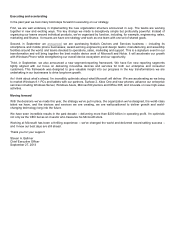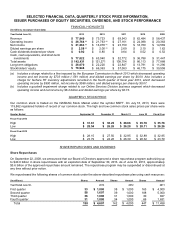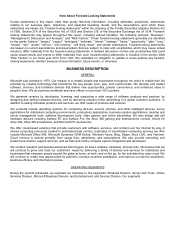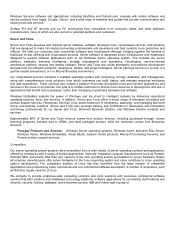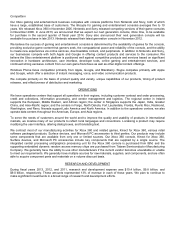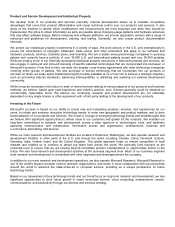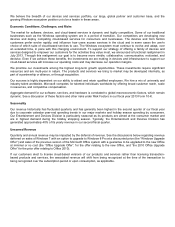Microsoft 2013 Annual Report Download - page 10
Download and view the complete annual report
Please find page 10 of the 2013 Microsoft annual report below. You can navigate through the pages in the report by either clicking on the pages listed below, or by using the keyword search tool below to find specific information within the annual report.companies focused on the Java Platform Enterprise Edition that compete with our enterprise-wide computing solutions.
Commercial competitors for our server applications for PC-based distributed client/server environments include CA
Technologies, IBM, and Oracle. Our Web application platform software competes with open source software such as
Apache, Linux, MySQL, and PHP. In middleware, we compete against Java middleware such as Geronimo, JBoss, and
Spring Framework.
Our system management solutions compete with server management and server virtualization platform providers, such as
BMC, CA Technologies, Hewlett-Packard, IBM, and VMware. Our database, business intelligence, and data warehousing
solutions offerings compete with products from IBM, Oracle, SAP, and other companies. Our products for software
developers compete against offerings from Adobe, IBM, Oracle, other companies, and open-source projects, including
Eclipse (sponsored by CA Technologies, IBM, Oracle, and SAP), PHP, and Ruby on Rails, among others.
Our embedded systems compete in a highly fragmented environment in which key competitors include IBM, Intel, and
versions of embeddable Linux from commercial Linux vendors such as Metrowerks and MontaVista Software.
Our cloud-based services face diverse competition from companies such as Amazon, Google, IBM, Oracle,
Salesforce.com, VMware, and other open source offerings. The Enterprise Services business competes with a wide range
of companies, including multinational consulting firms and small niche businesses focused on specific technologies.
We believe our server products, cloud-based services, and Enterprise Services provide customers with advantages in
performance, total costs of ownership, and productivity by delivering superior applications, development tools,
compatibility with a broad base of hardware and software applications, security, and manageability.
Online Services Division
Online Services Division (“OSD”) develops and markets information and content designed to help people simplify tasks
and make more informed decisions online, and help advertisers connect with audiences. OSD offerings include Bing, Bing
Ads, and MSN. We are also the exclusive algorithmic and paid search platform for Yahoo! websites worldwide. We have
completed the Yahoo! worldwide algorithmic transition and the paid search transition in the U.S. and several international
markets, and are transitioning paid search in the remaining international markets. Bing and MSN generate revenue
through the sale of search and display advertising, accounting for nearly all of OSD’s revenue. We have expanded Bing
beyond a standalone consumer search engine, and have integrated the technology into other Microsoft products,
including Windows 8, the new Office, Xbox 360, and Windows Phone, to enhance those offerings. We plan to continue to
incorporate Bing into our product and service portfolio.
Principal Products and Services: Bing; Bing Ads; and MSN.
Competition
OSD competes with Google and a wide array of websites and portals that provide content and online offerings to end
users. Our success depends on our ability to attract new users, understand intent, and match intent with relevant content
and advertiser offerings. We believe we can attract new users by continuing to offer new and compelling products and
services and to further differentiate our offerings by providing a broad selection of content and by helping users make
faster, more informed decisions and take action more quickly by providing relevant search results, expanded search
services, and deeply-integrated social recommendations.
Microsoft Business Division
Microsoft Business Division (“MBD”) offerings consist of the Microsoft Office system (“Office,” comprising mainly the core
Office product set, Office 365, SharePoint, Exchange, and Lync) and Microsoft Dynamics business solutions, which may
be delivered either on premise or as a cloud-based service. Office is designed to increase personal,



